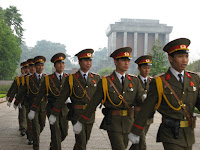 Spoiled travelers around these parts often complain of desensitization. I still generally find myself in awe of the world and want to keep it that way. Still, I bet even the most seasoned whiners in Southeast Asia cannot deny the beauty of Hanoi. Although I'm sure they'll whine about all the hostels there these days.
Spoiled travelers around these parts often complain of desensitization. I still generally find myself in awe of the world and want to keep it that way. Still, I bet even the most seasoned whiners in Southeast Asia cannot deny the beauty of Hanoi. Although I'm sure they'll whine about all the hostels there these days. For the first two weeks of January, Stephen and I traveled from Hanoi to Ho Chi Minh City by train. We flew from Phnom Penh to Hanoi, and, immediately, the Vietnamese capital exceeded all my expectations. We arrived in the midst of a pre-Tet (lunar New Year) celebration, and intricate, carefully manicured gardens and giant dragons made entirely of red chillis and flower blossoms lined the streets. Vendors lined the narrow streets, selling bowls of steaming pho and two-cent glasses of ice-cold local beer. In the midst of all these pleasures are constant reminders of the country's history and political state. Political propaganda—posters, flags, and images of Ho Chi Minh’s face are plastered virtually everywhere.

Other than all the giant, red signs, green is the most common color in Hanoi. In Asia, the “pave paradise, put up a parking lot” ethos is often an unironic way of life. Historic buildings are demolished and replaced with high rises; lakes filled and parks razed to make way for new developments. In Vietnam, a country that spent most of the last century at war, it’s amazing that its centuries-old architecture—and trees—somehow managed to survive.

Whenever we travel, Steve usually develops an objective/obsession with one sight he wants to see. In Hanoi, this was Ho Chi Minh’s Mosoleum. Arrive early. We learned this lesson the hard way, showing up too late one morning and having to return a few days later. Visitors can view the preserved corpse of communist Vietnam’s founder from 8 to 10 a.m. every day of the week except Monday. Locals take the ritual seriously, and dress in formal attire. After viewing the body, which resembles a Madam Tussaud’s wax replica, we headed to the adjacent Ho Chi Minh Museum, which is open all day, and contains loads of interesting war-era documents and artifacts, as well as odd modern art installations exalting the communist struggle. This is no place for someone who finds a particular political ideology offensive. Nor is Vietnam, for that matter.

After the mausoleum, Lenin Park is probably the second-biggest and most ornate homage to communism. It is anchored by a giant statue of the father of Soviet Russia, communist Vietnam’s benefactor and great friend. Inside, groups of women in track suits practiced aerobics in unison, kids played soccer, and lovers cuddled on benches looking out over Bay Mau Lake. In other parks around town, we spotted old men in fedoras and berets sitting on the sidewalks playing Tien Len, a traditional Vietnamese card game. We also saw a mid-day cockfight.




No comments:
Post a Comment